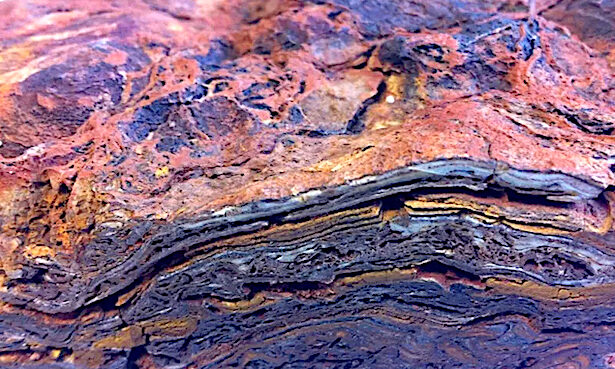
The fossils in question are stromatolites, layered rocks that are formed by the excretions of photosynthetic microbes. The oldest stromatolites that scientists agree were made by living organisms date back 3.43 billion years, but there are older specimens, too. In the Dresser Formation of Western Australia, stromatolites dating back 3.48 billion years have been found.
However, billions of years have wiped away traces of organic matter in these older stromatolites, raising questions about whether they were really formed by microbes or whether they might have been made by other geological processes.
"We were able to find certain specific microstructures within particular layers of these rocks that are strongly indicative of biological processes," said Keyron Hickman-Lewis, a paleontologist at the Natural History Museum in London, who led the research.
Microbial mats
The findings could have implications for the search for life on Mars, Hickman-Lewis told Live Science. The stromatolites in the Dresser Formation are encrusted in iron oxide from the reaction of iron with oxygen in the atmosphere. Mars' surface is similarly oxidized — thus the rusty orange color — but its rocks could hold similar structures left behind by ancient Martian life, Hickman-Lewis said.
Hickman-Lewis and his team examined Western Australian stromatolites first discovered in 2000 by study co-author Frances Westall at the National Center for Scientific Research (CNRS) in France. They used a variety of high-resolution 2D and 3D imaging techniques in order to peer into the layers of the stromatolite at a fine scale.
What they saw hinted at biological growth in all its messy glory. The researchers observed uneven layers, including little dome shapes that are indicative of photosynthesis, since microbes with the most access to the sun will grow more vigorously than those not as high in the structure. They also saw columnar structures that are typical in modern stromatolites, which are still found in a few locations around the globe.
Linda Kah, a sedimentologist and geochemist at the University of Tennessee who was not involved in the new study, said:
"Microbial mats give you layers that are uneven in their thickness and tend to be wrinkly or crinkly or go up and down on very small spatial scales. You end up with what looks like the characteristics of a microbial mat."Martian microbes?
The evidence that the Dresser Formation stromatolites are signs of ancient life doesn't make them the oldest life on the planet. That (possible) honor may go to stromatolites found in 3.7 billion-year-old rock in Greenland, or possibly to microfossils from Canada that might be as old as 4.29 billion years. It's very difficult to distinguish biological life from non-organic processes in these very old rocks, however, so these finds and others from a similar timeframe are controversial.
Based on the minerals in the stromatolites, the Western Australia microbial mats probably formed in a shallow lagoon fed by hydrothermal vents that was also connected to the ocean, the researchers reported Nov. 4 in the journal Geology.
The techniques used to study the Western Australian stromatolites could be useful for seeking life on Mars, Hickman-Lewis said, especially if Mars samples can be returned to Earth.
Scientists should consider some of the analyses here as a trial run of the analyses we will have to do in around a decade's time when we have materials from Mars.



It's happening, but buyer beware.